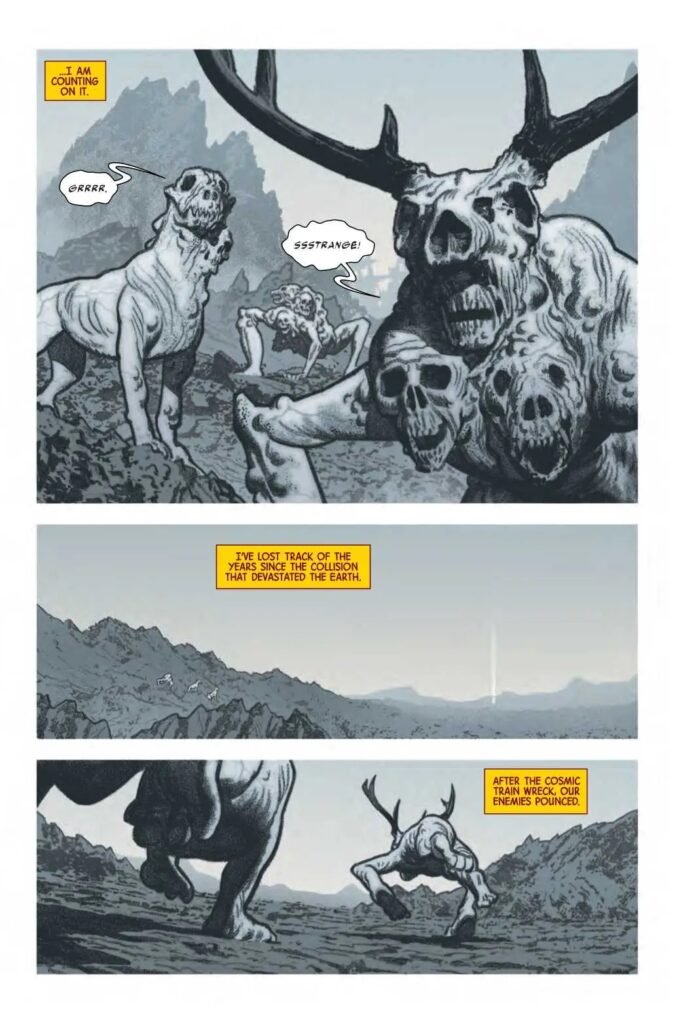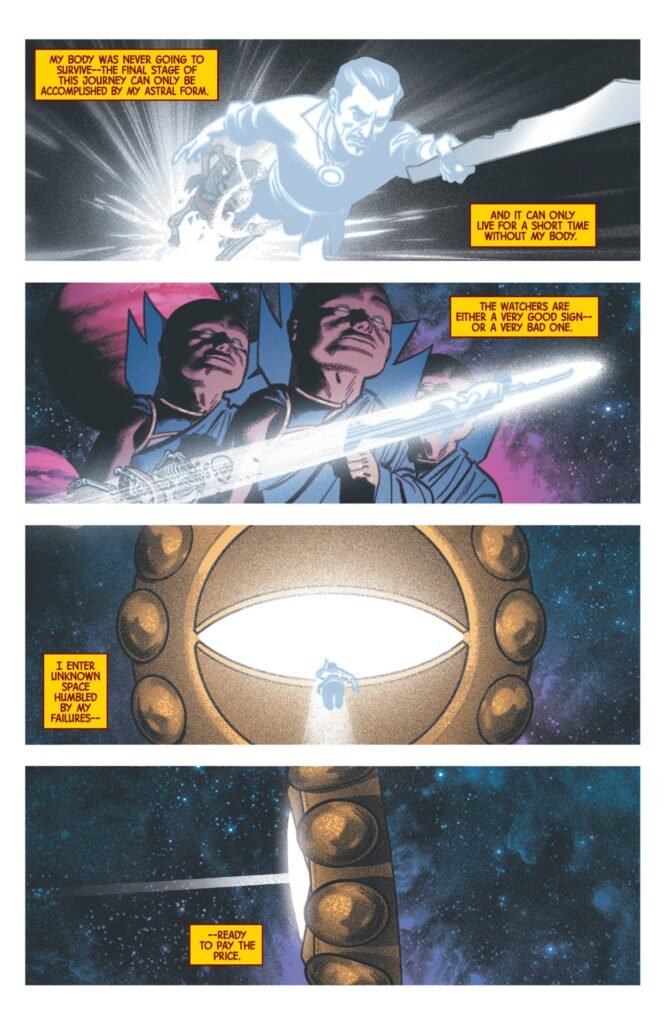Written by Gerry Duggan
Art by Greg Smallwood
Published by Marvel Comics, February 2019
In the current state of comics with its millions of titles and time-lines (a.k.a. the multitude of multiverses), it is always refreshing to find a one-shot comic that tells a small (if not epic) self-contained story. With this Doctor Strange book, Gerry Duggan and Greg Smallwood manage to walk us into a brand new timeline with familiar characters and ideas from the Marvel Universe but do so with such grace from beginning to end that you are left satisfied with story, art, and ending. A rare feat.
I would love to see the raw script for this comic. I’d like to compare Mr Duggan’s descriptions to Greg Smallwood’s visual decisions. While Mr Duggan’s writing is sharp, witty, and fresh, it is Mr Smallwood who makes this issue shine.
The plot
The story, a last days of Doctor Strange tale (a major theme rushing through comics since Old Man Logan first walked the Wasteland), starts with an ancient and blind Doctor Strange walking through the ruins of what foggily appears to be a city when he stoops down to pick up a rock. He puts it in a pouch that hangs from his side. He is traveling light. He has nothing more than a golden medallion and this pouch. His clothes in tatters.
Feeling the end of all things are near, we get the feeling that when he removes one of his eyeballs it might be his first heroic act in ages. Heroic because this is the price he pays to use magic. Magic does not come easy or unpunished in these last days. Strange places the eyeball into the golden medallion. The eye of Agamotto lights up and leads him. He knows that, his enemy, Dormammu’s henchmen (skull infused demon dogs?) will feel the magic of the newly opened eye and come for him. Dormammu now rules the world. Strange ties a rag around his head, covering his empty eye socket and walks farther into a barren landscape.

The demon dogs of Dormammu pick up his scent and are after him. These creatures are expertly drawn by Mr Smallwood and almost given his black and white treatment that he used so successfully in his amazing Moon Knight run with Jeff Lemire. Mr Smallwood is also incorporating the same digital crayon brush for his final drawing: so much different than the hard– and boring– digital inks that so many artists use. Mr Smallwood’s coloring avoids the shiny soft airbrush that also dominates comics today. Open this book and you can instantly feel that this is a step above what you normally see in an Avengers comic. (I write, in awe, about the art further, below.)
Strange sips water from a puddle amongst more ruins and a voice from the pouch speaks, They’re hunting you, Stephen. Cue the attack of the demon dogs. Strange battles. The demon dogs have him pinned and he yells at the rag around his head. It wakes up and we realize it is the remains of the Cloak of Levitation. Mr Duggan does a great job of making the familiar fresh. It is a great reveal. Subtle and perfectly timed. A slight laugh that you didn’t see it coming. But the action does not stop. Strange uses magic to whisk away the demon dogs and coughs badly. The thing in the pouch reminds Strange that Strange is dying. Strange tells the thing to just be ready to do its part when Dormammu comes.

Strange walks on. In the dark of night, he finds a shard of something metal sticking up in the middle of a crater. He is elated to have found it. Strange uses magic flames to give himself a night light and warmth in the desert. He falls asleep.
And we fall into a warm tinted dream/flashback: Clea leaves him. Villains from the past tumble through his memories.
A voice awakens Strange. Dormammu and his demon dogs have found him. They are sitting right next to Strange, unafraid of the former Sorcerer Supreme. Mr Smallwood’s art shines: Dormammu’s flaming head is gorgeous in the dark night. Dormammu does some standard villain bragging and exposition before he begins to disarm Strange. But Strange reaches into the pouch and pulls out the talking thing: the (shrunken?) head of the Hulk. Hulk is skeletal and seems asleep. Strange tells Hulk the rest is up to him.
Dormammu sends a magical blast at Strange and the head of Hulk: “DIE!”
When the magic dust clears, the Hulk looks healthy, happy, and twice the size he just was.
Strange has been slowly changing the Hulk’s diet. Instead of being fed by Gamma Rays, Hulk now eats magic.

Strange had planned the entire thing. The shard of metal was what remained of Silver Surfer’s board. Strange no longer had the magic left in himself to get the board to fly. Strange uses the magic of Dormammu’s death to create a magical mushroom cloud of an expansive energy. It is enough to send Strange on an astronautical journey. Strange grips the board and peels off of earth and into the unknown.
Strange is reduced to nothing but a living skeleton hanging on to dear life as the shard of the Surfer streams through both time and space. The Watchers see Strange fly by. Strange, somehow, enters a giant Eye in space and speeds through the intersections of the multiverse (a retro filled two page splash of vivid colors) and eventually lands dead in a wasteland cabin. His death is a warning to his friends that Dormammu will take over the future. But now they know and can stop it from happening.

Mr Duggan does a rare thing in the superhero genre with this comic: he expands the mythos of a legacy character and stays true to the character we know. As our comic heroes have aged (Batman and Superman are in their eighties. Spider-man and Dr. Strange are sixty!) we are well aware of their personalities, powers, and abilities.
But here, Mr Duggan makes the older Strange have to adapt to his own limitations: his advanced age, not much magic left at his disposal, etc. Instead of being the wily sorcerer with a multiverse of tricks up his sleeve, Strange is confined to making a plan that must succeed. There is no back up. No ace up his sleeve. Just his experience and wisdom and the very things that make him who he is. Not his powers of magic but his powers of mind. Older heroes must change their tactics as they themselves change. Mr Duggan slips in a nuanced understanding of character, time, and space in this story and it really creates something special for Dr. Strange. He remains the character we know: perhaps even more so as Mr Duggan has stripped him down to his core.
I didn’t read the other Best Defense one-shots (of which this is one, issued by American publisher Marvel Comics). While they did have some great creative teams, I saw nothing that compared to Mr Smallwood‘s cinematic beauty. This comic is why we collect comics. No, why we read comics. It is a blast of nostalgia. It’s a blast of energy. It is a blast.
The art
Of course, most comics are a hastily written series of tropes and motifs that died long ago. The superhero comic book overload in contemporary media is a decade old if not older and yet it is the simple things like this one shot that keep us coming back. I do not pick many mainstream comics anymore but I have been a sucker for Mr Smallwood’s art since those first few issues of Moon Knight. The style is clean and very retro. (He is really pushing that retro vibe with his new DC book The Human Target with Tom King. The backgrounds scream 50’s and 60’s Looney Tunes and are my favorite part of that book. The economy in creating space is matched by perhaps no one in the business today. This book has been on hiatus and returns this fall with the second half of the 12 part series.) [Editor’s note: see our review of the Human Target in this link: The Human Target #5 and 6 (review) – World Comic Book Review .]
I am amazed at his economic drawing and elegant lay-outs. In this book, the lay-outs consist mostly of a repetition of quartered horizontal panels. Cinematic in every respect. When he does break the simple pattern of four panels, he combines two or three of them to create large panels or occasionally a full page splash but everything lives in the same concise visual language. His choices for everything in the artwork are spot on. You fly through the story with such energy it is a joy to read. Paced to perfection.

Mr Smallwood’s characters are well designed and excellently drawn. He does his own colors on this book and the majority of it is a perfectly muted palette. Cool washed out grays dominate and give the story that feeling of a ruined future. These choices also make the more ambitiously colored pages– when magic is used, during flashbacks, or when flying through the multiverse– really pop off the page. From start to finish, this comic feels complete and intentional. The script stays small, tight, and clean: a masterclass in tease and pay-off. Every little detail is weighed and considered. Page turns, numbers of panels, and splash pages all in the perfect places for excellent pacing. Everything in its right place and nothing left dangling. Nothing more needed from these wonderful 33 pages.
Conclusion
I have come back to this book more often in the last few years mostly because of the artwork but re-reading it again and again, I find the storytelling both compelling and inspiring. In both word and picture. This is the reason to grab a one-shot or annual: to find a golden nugget in the muddy river of disposable comics that flood local comic shops. For this book, I picked up the Skottie Young variant cover for cheap but also recommend the second printing cover which is an image from the interior of the book–the flight through the multiverse. The Christian Ward cover is also excellent and fits with everything in the book. It’s a wonderful little seed of a comic and I look forward to finding more like this.

